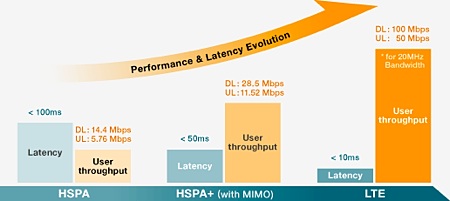This article is more than 1 year old
Cutting the cord: future mobile broadband tech
How internet on the go is going to get much faster
In the past, governments, through their regulatory bodies, awarded radio spectrum to groups who could most benefit the citizens governed, ensuring compatibility by mandating technologies and shifting radio spectrum around to provide competition where it was thought beneficial. More recently, governments have begun to see radio spectrum as a nice little earner, with the fall-back ideology that the highest bidder would have the biggest incentive to make efficient use of the spectrum - a process that came to a head with the 3G auctions where companies fell over each other to bid more money than they had for radio spectrum in which they were required to deploy a specific technology, over a specific quantity of the country, within a specific time.
Mobile WiMax Timeline

Many of the bidders failed in their obligations on coverage and deployments, though all followed the technology requirements. In the UK, all the operators, except Vodafone, bid for the 5MHz of spectrum allocated for TDD use. But no one is using TDD networks, and the licence forbids the deployment of anything else in the band, and so that part of the spectrum lies empty.
Examples like that, of which there are several, have helped pushed the regulator towards selling off radio spectrum without restriction, but it's still not possible for the regulator to avoid revealing a technological leaning. Taking Ofcom's plans for the Digital Dividend as an example: the vast majority of the spectrum will be sold off in paired lumps, ideally suited to an FDD technology like LTE, but not ideal for the TDD system currently used by WiMax.
A couple of blocks will be sold off without pairing, but the delays in working all that out - and a couple of conveniently-timed court challenges from T-Mobile and Telefonica - have seen the sale of spectrum that might have been used for WiMax delayed until well after the lead the standard has established had ceased to be relevant.
Just as radio spectrum has become more flexible, so the standards have become more encompassing. 4G mobile standards aren't happy just connecting mobile phones to basestations, they want to be used for backhaul too - connecting the microwave relays dotting the nation at very high speed and very high frequencies, not to mention competing with ADSL for fixed broadband connections. Both LTE and WiMax can operate on just about any frequency, and both are expected to be deployed in a wide variety of roles.

Bandwidth and latency: LTE vs HSPA
Source: NEC
But LTE is more flexible than WiMax. It's able to operate in 1.25MHz increments of spectrum up to 20MHz - a bandwidth that can offer 160Mb/s downstream using two antennae, or more than 300Mb/s if you can squeeze in four aerials. On the upstream, LTE promises 86Mb/s eventually, but like the downstream that will be phased in over time with initial deployments offering closer to a quarter of that. WiMax may already be deployed, notably by Clearwire in the states, but those deployments are only offering 4Mb/s: a speed that's also already attainable on a 3G network with HSPA and hardly an advertisement for the next generation of technology. Rival US operators are committed to deploying LTE over the next few years.
